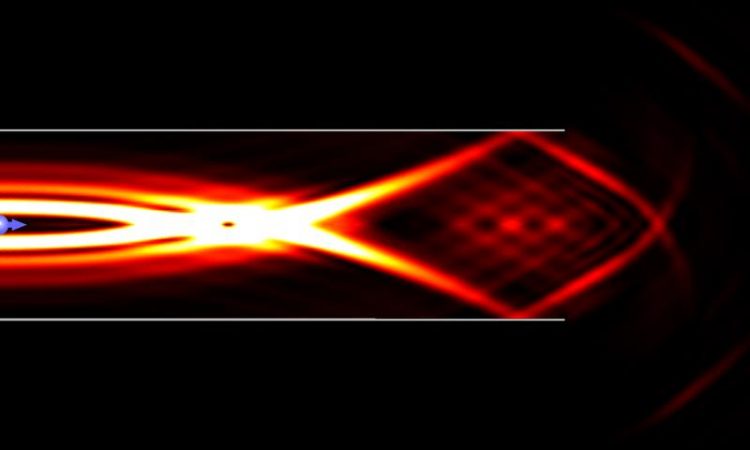Physicists Design Ultrafocused Pulses

With this setup arbitrarily focused pulses could be generated IQOQI Innsbruck
Microwaves, heat radiation, light and X-radiation are examples for electromagnetic waves. Many applications require to focus the electromagnetic fields to small spatiotemporal dimensions. Engineers may use different methods to achieve this.
In the journal Physical Review Letters, researchers in Oriol Romero-Isart’s group at the Institute of Quantum Optics and Quantum Information (IQOQI) and the Institute for Theoretical Physics at the University of Innsbruck together with Ignacio Cirac and Theodor Hänsch at the Max Planck Institute of Quantum Optics, Munich, have published a new scheme for generating ultrafocused electromagnetic fields.
Surprising behavior
When electric current flows through a coil, it produces electromagnetic waves that propagate in all directions. When the coil is placed inside a cylinder that reflects the waves perfectly a surprising phenomenon happens. “With this setup arbitrarily focused pulses and quasi-equidistant pulses could be generated,” says junior scientist Patrick Maurer. “The more waveguide modes are excited, the more focused the electromagnetic fields become.”
The theoretical physicists analytically characterized the system to such a degree that, based on the reflections of the electromagnetic waves on the inside of the cylinder, they were able to design a current pulse that excites a clearly defined number of modes. “Because of the specific properties of the system, the current pulse needs to be adjusted only slightly in order to change the number of modes or, in other words, to focus the field more strongly. The average frequency of the pulse basically remains the same,” explains Jordi Prat-Camps, Postdoc in Romero-Isart’s research team.
The spectrum of the generated field is determined by the radius of the cylinder. For example, focused microwave pulses can be generated by using a cylinder that is several centimeters thick.
Technological challenges
The physicists in Innsbruck were able to confirm their analytical calculations with numerical simulations. They showed that the fields kept their unique properties for some time after they exited the cylinder through one of the openings. This new concept is of interest for technological applications that require ultrafocused fields to work.
For example, in the field of microscopy this new scheme could facilitate the development of even more precise devices. To implement their scheme, the physicists point out two requirements: “First, we need to find a material that perfectly reflects in a broad frequency range,” says Prat-Camps. “In addition, we have to precisely generate the calculated current pulse. The better these requirements are met, the clearer the visibility of the desired effect will be.”
This work is supported by the European Research Council and the Austrian Federal Ministry of Science, Research, and Economy (BMWFW).
Publication: Ultrafocused Electromagnetic Field Pulses with a Hollow Cylindrical Waveguide P. Maurer, J. Prat-Camps, J. I. Cirac, T. W. Hänsch, O. Romero-Isart. Phys. Rev. Lett. 119, 043904 DOI: 10.1103/PhysRevLett.119.043904 (Preprint: https://arxiv.org/abs/1705.03231)
Contact:
Patrick Maurer
Institute of Quantum Optics and Quantum Information
Austrian Academy of Sciences
phone: +43 512 507 4731
email: patrick.maurer@oeaw.ac.at
web: https://iqoqi.at/en/group-page-romero-isart
Christian Flatz
Public Relations
Phone: +43 676 872532022
Email: pr-iqoqi@oeaw.ac.at
http://dx.doi.org/10.1103/PhysRevLett.119.043904 – Ultrafocused Electromagnetic Field Pulses with a Hollow Cylindrical Waveguide P. Maurer, J. Prat-Camps, J. I. Cirac, T. W. Hänsch, O. Romero-Isart. Phys. Rev. Lett. 119, 043904
http://iqoqi.at/en/group-page-romero-isart – Quantum Nanophysics, Optics and Information
Media Contact
All latest news from the category: Physics and Astronomy
This area deals with the fundamental laws and building blocks of nature and how they interact, the properties and the behavior of matter, and research into space and time and their structures.
innovations-report provides in-depth reports and articles on subjects such as astrophysics, laser technologies, nuclear, quantum, particle and solid-state physics, nanotechnologies, planetary research and findings (Mars, Venus) and developments related to the Hubble Telescope.
Newest articles

NASA: Mystery of life’s handedness deepens
The mystery of why life uses molecules with specific orientations has deepened with a NASA-funded discovery that RNA — a key molecule thought to have potentially held the instructions for…

What are the effects of historic lithium mining on water quality?
Study reveals low levels of common contaminants but high levels of other elements in waters associated with an abandoned lithium mine. Lithium ore and mining waste from a historic lithium…

Quantum-inspired design boosts efficiency of heat-to-electricity conversion
Rice engineers take unconventional route to improving thermophotovoltaic systems. Researchers at Rice University have found a new way to improve a key element of thermophotovoltaic (TPV) systems, which convert heat…



